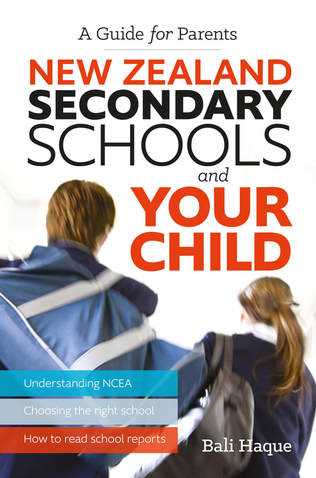
by Bali Haque
Bali Haque’s latest work is New Zealand Secondary Schools and Your Child: A Guide for Parents and the book certainly lives up to the promise inherent in the title, for it is a carefully-compiled and comprehensive response to an often-heard observation that “I’ve no idea what they do at school these days.” Whilst it’s good to know that schools are therefore keeping up with the pace of change in society, it’s equally comforting to know that books such as this one exist to help lay people pick a path through what can be a confusing and even tortuous process.
In its 77,000 words arranged in eleven chapters, the Guide considers the choice of school; its structure including governance, teachers, discipline systems, pastoral care and bullying; the curriculum; and perhaps most important of all from a vocational perspective, the minefield of the NCEA process and results; reports and interviews, and special needs.
All these are explained in precise and impeccable language which is also conversational, and mercifully jargon-free. This is nowhere more noticeable than in the sections devoted to NCEA. One suspects that this will be the major selling-point of the book, for that section is as excellent as one would expect given the author’s background in that area. On looking at the notes made during the reading process, one is struck by the number of times the words “clear”, “logical”, “well-explained”, “comprehensive”; and “sound advice” appear, for the benefit of a parent in need of good advice.
As noted, it is a comprehensive and valuable guide to parents of secondary school students, and that cannot be overstated. Teachers, especially those who endured the birth-pangs of ‘Tomorrow’s Schools’ in the early nineties, may well have viewpoints that are not apparent to the parents for whom the book is intended, and that is as it should be. One such instance is the author’s comments on how the principal ‘holds most of the (power) cards’ and it is tempting to respond that, while schools have always been driven by professionals, until the restructuring wrought by the Fourth Labour Government they were supported in that by a team that included professional overseers in inspectors and advisers and administrative professionals in the ten departments of education throughout the country.
Under the premise that anyone could administer and oversee education, Lange’s contribution to educational restructuring was to strip away the support network so that the burden of guidance for lay people devolved upon principals alone, and whilst Haque acknowledges this, it seems uber-critical to cavil at the power which that functionary wields faute de mieux.
Similarly, I found myself questioning whether the section in chapter three that deals with pedagogy, and in particular pages 76 and 77, offering a ‘checklist’ of teacher competence that can be used by lay people, ought really to be in a book that offers parents the ‘big picture’ of secondary education. In this, it is easy to see ‘the administrator view’, one which is often at variance with that of a teacher facing thirty-odd students, whom Haque himself is generous enough to admit are not always tractable or even interested in a subject which may not be a teacher’s strength, in a room which is often too small for the sorts of interaction he lauds.
Those reservations aside, though, this is an outstanding guide for parents to the New Zealand secondary school and will be worth every cent of its modest purchase price to the market at which it is aimed.
Author: Bali Haque
Publisher: Bateman
ISBN: 978 186953 959 7
RRP: $34.99
Available: bookshops

 RSS Feed
RSS Feed
